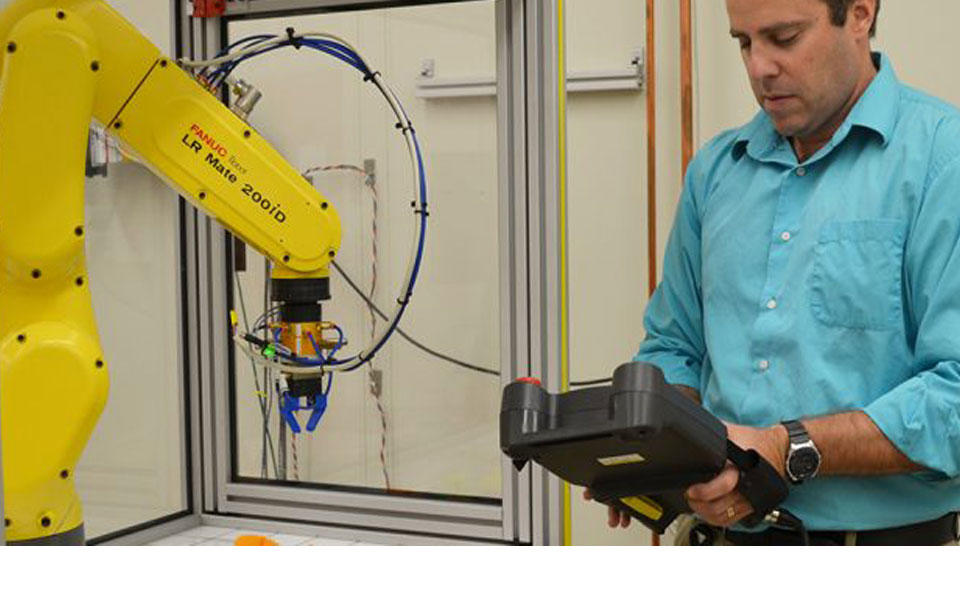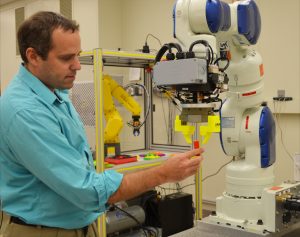Taking Measure
Just a Standard Blog

Whether they’re behind the scenes assembling products or helping you parallel park your car, robots are already playing a big role in our day-to-day lives.
And robots will only become a more pervasive part of our lives in the coming decades. But they aren’t good at everything ... yet. For instance, robots in manufacturing don’t “think on the fly” very well.
In a word, their movements can be a little mechanical.
Robots do well in highly structured environments where the location of objects are known and where all they have to do is perform the same task over and over and over again. Not surprisingly, you’re more likely to see robots do things like manufacture cars than you are to see them doing job shop-type operations where only a handful of similar products are being made at a given time.
Another way to describe their limitations is to say that robots are not agile. But, in order for them to be useful to small manufacturers and to also allow larger manufacturers to offer more automated customization of high volume products (think cars and cell phones), they need to be able to bend over backwards, metaphorically—and sometimes literally—speaking.
NIST is addressing this challenge head-on with our Agility Performance of Robotic Systems Project. The goal of this project is to help manufacturing robot systems be more agile and to develop the measurement science that will allow manufacturers to assess and assure the agility of their robot systems.
Some of the key areas we’re looking at include:
- the ability of a robot to be rapidly re-tasked without the need to shut it down when a new operation needs to be performed;
- the ability of a robot to recover from errors, so that when a part is dropped, for example, the robot can assess the situation and determine the best way to proceed in order to accomplish its goal; and
- the ability to quickly swap robots from different manufacturers in and out so that a company is not tied to a single robot brand.

Humans are generally agile, but there’s more intelligence behind that agility than we realize. For instance, humans understand what they are capable of doing, e.g., how much we can lift, how far we can reach, etc. We understand the characteristics of objects in the environment, e.g., how much objects weigh, where they are, etc. We’re able to gather information and use reason to interpret it, e.g., that an object is too heavy to lift, but that we could push it to the right location. And finally, we’re able to develop a plan, often on the fly, with respect to how we can use information to accomplish some goal, e.g., we pick the part up, turn it over and place it on the conveyor belt.
NIST is developing foundational standards to help robot manufacturers design robots that can make these kinds of improvisational, agile actions. For instance, we and our partners in industry and academia published the IEEE 1872 Standard, Core Ontology for Robotics and Automation. This standard provides a starting point for representing characteristics of objects in the environment and the capabilities of the robot—knowledge that is needed for robots to be able to plan and adapt as events unfold.
We are also developing the Canonical Robot Command Language (CRCL), which is a low-level messaging language for sending commands to, and receiving status from, a robot. CRCL is intended primarily to provide commands that are independent of how the robot is controlled. This allows robots to be more easily swapped in and out since the commands are represented in a brand-agnostic, interoperable format.
We’re also in the process of developing a set of performance metrics to measure robot agility, which we are going to validate at the upcoming Agile Robotics for Industrial Automation Competition (ARIAC) in 2017. Co-sponsored by ABB, Siemens and Dassault Systèmes, ARIAC will let teams test their robot control systems on a simulated manufacturing factory floor where we’ll throw agility challenges at them and see how well they respond.
There are exciting times ahead of us, and robots will likely play an increasing part in them. Through many efforts, such as the ones listed above, we are striving to allow robots to be more productive, easier to program, and more agile so that they can accomplish tasks that were never before possible.
You can learn more about ARIAC by watching the video (starring me!) below:
About the author
Related Posts
Comments
- Reply





